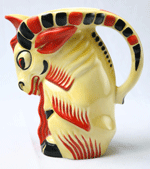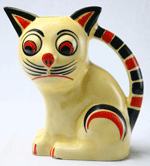|
Colorful Czech
Ceramics Rate A Second
Look
By Anne Gilbert
It has been decades since ceramics made in Czechoslovakia have found a
serious buyers' market. In fact, when examples made rare auction appearances,
prices were often under fifty dollars. Brightly colored kitchen canister sets
could be had for under $100. It was the beautiful, glass perfume bottles made
there during the early 20th century that have lured collectors.
An upcoming
Garth's "Eclectic" auction may change all that. Some Czech figural pottery
pitchers have estimates of $200-$400. After viewing these cheery animal and bird
pitchers, I researched them on the Internet and found several dealers offering
the same items, retail, for $500 and up. I learned a lot more in my own library
from a book published in 1993, Made In Czechoslovakia, Book 2, by Ruth A.
Forsythe. It can still be purchased at Barnes and Noble. Loaded with color
photos.
For starters, I learned that there are several categories of Czech
ceramics: Peasant Art, provincial (1917 to 1933); Art Deco (1920s-1933); Amphora
and Amphora type; Majolica; and luster and iridescent. In addition to pottery
items, porcelain and semi-porcelain dinner sets were made.
Joseph Mrazck was
one of the best known Czech pottery artists. In his teens, he came to America
and later opened a pottery specializing in peasant-style pottery in 1917 in New
York. It was so successful that he started a factory in Czechoslovakia. The
"Peasant Art Industries" exported to some of America's top stores in
Philadelphia and Chicago. His later Art Deco colors and motifs were used on a
wide variety of objects such as pitchers, clocks, lamps, figurines and
utilitarian kitchen canister sets.
Amphora pieces in vase shape were made in
high glaze, mat finish or both. The name comes from the two-handled,
narrow-necked vessel used by the ancient Greeks and Romans to hold oil, wine and
liquids.
During a revival in the 1920s of the centuries, old majolica pottery
techniques a variety of pieces were made in Czechoslovakia and exported to
America. Luster glazes were used from the 1920s to the 1930s.
CLUES: There
were dozens of types of marks, mostly ink stamped. Pieces marked "Erphilia" are
short for the Philadelphia importing firm of Ebeling and Reuss of Philadelphia.
If a piece is marked "Made in Czechoslovakia," that means it was made after
1920. To add to the confusion, one factory could have more than a dozen names
and motifs.
If you like the look, now is the time to start collecting. Flea
markets and garage sales are a good place to start hunting.
|

Czech Art Deco pottery ram
figural pitcher.

Czech Art Deco pottery cat figural pitcher. (Photo, Garth's Eclectic Auction,
Delaware, Ohio.)
|